
From cross-border payments and tokenized asset trading, to fraud reduction and financial inclusion, CBDCs and stablecoins offer a wide range of transformative benefits for the broader financial ecosystem.
an article written by Ripple Team
Central Bank Digital Currencies (CBDCs) and stablecoins have the potential to help digitize entire economies and represent a powerful force for unlocking the Internet of Value. You can learn more about CBDCs and stablecoins and the wide range of transformative benefits through Juniper Research’s recent report Understanding CBDCs & Stablecoins. Explore it and you will gain an understanding of the relevant taxonomy and key use cases in the current competitive landscape.
In the second piece of an ongoing series, we will delve into the world of CBDCs, explaining what the advantages and considerations are of the exciting proposition. Catch up on the first blog of the series where we delve into the world of CBDCs, explaining what they are, how they work, and why they are becoming increasingly important in the global financial landscape.
Today, 130 countries, representing 98% of global GDP, are pursuing CBDC projects. Some, including the United States and South Africa, have entered exploratory phases. Many projects throughout the European Union are in development, while China has reached a pilot phase and is nearing full scale launch in mainland areas. The Atlantic Council reports that 19 of the G20 countries are now in advanced project stages.
Elsewhere, including in Nigeria and the Bahamas, solutions have been launched and use cases continue to evolve. The Bank for International Settlements now predicts that 20% of the world’s population will have access to a CBDC within the next few years.
In a recent Ripple survey of global financial institution leaders, eighty-five percent (85%) of respondents think that their country will launch a digital currency within the next four years. The majority of leaders cited financial inclusion as a key CBDC benefit; and many of them feel the technology will deliver enhanced national competitiveness (44%), ensure greater efficiencies within payment systems (43%), and advance innovation more broadly (42%).
According to McKinsey, CBDCs may help central banks address systemic objectives including: ensuring financial inclusion, reducing fraud and money laundering, stimulating payments innovation, and creating a new vehicle for monetary policy, among others.
Worldwide, jurisdictions appreciate various CBDC functionalities for a range of reasons. For instance, some recognize the opportunity to expand the portion of currency reserves made up of sovereign money – or the money issued by a monetary authority versus private bank money owed by banks to their customers and borrowers. Increasingly, many Central Bankers want to counter the dysfunction of some bank money regimes, and employ bank money that is not threatened by crises.
CBDCs are needed to support the most significant positive impacts of asset tokenization, an increasingly targeted mechanism for transforming tangible assets (e.g. real estate and intellectual property) into digital tokens stored on the blockchain. With tokenization, anyone can view the process of asset transfer through ownership.
Efficient settlement of asset exchange is not as impactful if the cash component of the transaction isn’t as equally efficient and able to be coupled into a single atomic update. Wholesale CBDCs, for example, are designed to settle large-scale, high-value securities transactions and interbank transfers, affording operational efficiencies around speedier settlement times and greater liquidity when settling other assets like tokenized real estate.
In addition, tokenization improves privacy and agility as assets move peer-to-peer without the need for centralized intermediaries within decentralized networks. Governments increasingly recognize the implications of tokenization to improve conventional asset ownership and investment models. Tokenization also provides more flexibility and options under appropriate governance (i.e. central banks in the case of CBDCs). This enables a new balance between data sharing and privacy needs, providing increased transparency and certainty that isn’t possible with traditional technologies.
From transfer, payment and settlement of an asset, to tracking and updating a lien on an asset for credit availability (e.g. tokenized real estate), CBDCs help to enable a wide range of use cases for tokenized assets beyond just value exchange. With the underlying blockchain technology, the holy grail of instant transfer and settlement via a distributed ledger is made possible across any tokenized asset.
Despite expected benefits, CBDC deployment is a new frontier and potential challenges should be considered. While these may shift depending on design models, implementation challenges can include:
. Increased centralization of payment processing and sensitive user data (it is possible a central bank would store user activity and transactions)
. Reduced regulatory oversight of financial systems
. Increased difficulty reversing fraudulent or erroneous transactions
. Challenges in payment credential management and key custody
. Susceptibility to erroneous or malicious transactions enabled by complex, automated financial applications
. Increased reliance on third parties (e.g. non-banks)
Download the full whitepaper for a comprehensive understanding of what Central Bank Digital Currencies are. Learn of the promise CBDCs hold for developing markets including large subsections of Africa, Latin America, and Southeast Asia where infrastructure lacks and physical financial services access is limited.
Banking 4.0 – „how was the experience for you”
„To be honest I think that Sinaia, your conference, is much better then Davos.”
Many more interesting quotes in the video below: